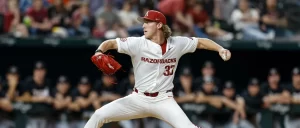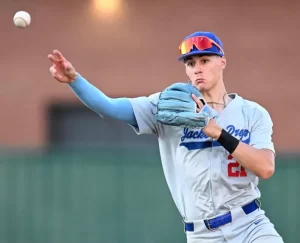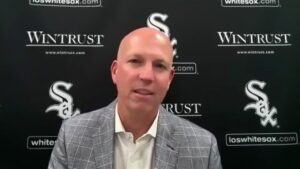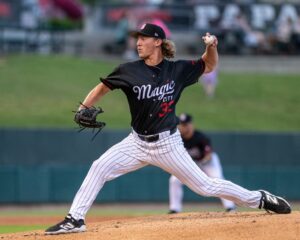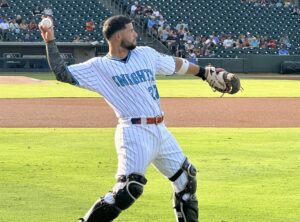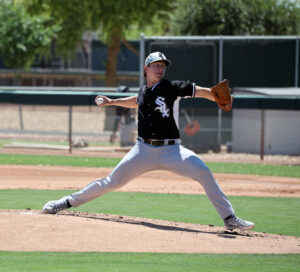Draft Preview: Best of the Rest
Kolby Allard, LHP, San Clemente HS (CA):
Allard may be the top high school arm in the 2015 draft, but a back injury has held him back this year and he has not thrown since March. “He sits 90-93 and has been as high as 97 mph with a clean delivery, feel for a changeup and an above average to plus breaking ball” per Kiley McDaniel. Along with the premium stuff, MLB.com rate his control as a “plus” and Baseball America mentions that he has “a feel for the strike zone.” If he hadn’t been hurt then he would have been a likely top 10 pick, but he should still go in the first round despite his lack of size (listed at 6’0” but probably a little shorter than that).
Andrew Benintendi, OF, Arkansas:
Benintendi has been a late riser as a draft eligible sophomore who has posted outstanding numbers including a .390/.491/.723 triple slash line, 18 home runs, 42 BB/30 SO and 22 stolen bases. The power is new for Benintendi. He hit just one home run last year as a freshman but has added strength since then and seen his home run output takeoff as a result. In addition, MLB.com rate Benintendi as a “plus” defender in centre field and Baseball America say that he “may be the best combination of athleticism and production in this college class.” Baseball America, FanGraphs and MLB.com all have him ranked within their top 10. Benintendi’s size (listed at 5’10”) and lack of track record are a concern, but he would be a great backup option at #8 as a college bat with upside if all the top arms are gone.
Phil Bickford, RHP, JC of Southern Nevada:
Bickford was drafted at #10 overall in 2013, but couldn’t come to terms with the Blue Jays and ended up at Cal State Fullerton. After an impressive Cape Cod league showing last year he elected to transfer to CSN in order to be eligible for the 2015 draft. Bickford’s stuff comes and goes. His fastball was up to 96 in high school, but was then more 89-92 at Fullerton, before getting back up to 93-98 while pitching in relief in the Cape. This year his velocity has been back down in the low-90’s with inconsistent secondary offerings, which has caused his stock to fall from possible top 10 guy to more of a late first rounder.
Alex Bregman, SS, Louisiana State:
Bregman’s calling card is his contact hitting ability. This season he has struck out just 20 times in roughly 290 PA’s, which is phenomenal. His career average at LSU is .336, and he hit a massive .369 as a freshman. He’s got a great understanding of the strikezone and has 87 BB/66 SO for his college career (with 36 BB/20 SO this season). As Baseball America mentions, Bregman has a “flat bat path and contact-oriented swing,” which will aid his ability to hit for average but may suppress his power output. Scouts have questioned his ability to stick at SS in the past, but as Kiley notes “the industry is slowly coming around to my opinion that he can stick at shortstop.” Bregman is unlikely to be available for the Sox at #8, with the Red Sox at #7 widely seen to be his floor.
Daz Cameron, OF, Eagle’s Landing Christian Academy (GA):
Many scouts were projecting Daz, son of former Sox outfielder Mike Cameron, as a potential 1-1 candidate back when he was a high school sophomore. He hasn’t quite developed as expected since then, but he still possesses a starting centre fielder skillset. His strengths, per Baseball America, include “exceptional hand-eye coordination, incredibly fast hands, elite bat speed and the potential for above-average power.” MLB.com call him a “plus” defender in CF, with “fine instincts in all phases of the game.” There have been concerns about Cameron’s lack of hitting against the top high school arms and his approach at the plate, but the upside is high, especially if his gap power develops into home run power.
Kyle Funkhouser, RHP, Louisville:
Funkhouser started the season strong, saw his velocity spike and looked like a certain top 10 pick, but as Kiley notes “he’s fallen apart since, now sitting around 90 mph with no crispness and diminished command.” Kiley has dropped him from #9 to #30, and says that teams think he may be hurt. At his best he looked like a potential #2 starter and would have been an excellent target for the Sox at #8, but he’s unlikely to be in play for the top 10 now, and he slipped to the 23rd pick in BA’s most recent mock draft. His numbers this year at Louisville are pedestrian, with an 8.46 K/9 and 3.67 BB/9, and his command has always been an issue. His slider has shown plus at times and his change needs work.
Ian Happ, OF, Cincinnati:
Happ has been a productive hitter for Cincinnati over the past three seasons. He’s a switch hitter with “excellent bat speed from both batters’ boxes” per Baseball America. Kiley describes him as “one of the most advanced bats in the draft” and he should hit for both power and average. A lot of Happ’s draft value will be tied to his perceived defensive home. Happ will be valued more highly by teams that feel he can be a pro 2B, but his current ability to play second base been described as both “not particularly fluid” and “he lacks smooth infield actions,” so clearly he will need a lot of work there. Conversely, Happ’s value will be lower for teams that see him as an outfielder, as his lack of range and arm will likely relegate him to left field. If the Sox want a bat that will move quickly then Happ is likely the best option, and he should come at a discount from slot too.
Nathan Kirby, LHP, Virginia:
Entering this season Kirby was seen as a possible top 5 pick as a lefty with three above average pitches and a chance to reach the Majors quickly. Since then he has slipped as his stuff backed up and his control has been very poor this season with a 4.55 BB/9 (up from 2.62 BB/9 last year). Per MLB.com, Kirby’s fastball has been “up to 94 mph in the past, but was sitting around 89-91 mph this spring” and Kiley saw him “throwing average stuff with no conviction by the 3rd inning.” He was shut down a few weeks ago with a strained lat after throwing only 59.1 innings. A possible #3 type starter at his best but more of a #4/5 starter with his most recent stuff. There should be better college starters available at #8.
Kevin Newman, SS, Arizona:
Like Alex Bregman, Newman is a shortstop with an excellent hit tool and he has stuck out a mere 15 times this season. Some scouts have graded his power as a legitimate 20 on the 20-80 scale, so as you can probably guess he’s mostly a slappy, singles hitter. He’s not a lock to stick at short either, and doesn’t have the patience that Bregman displays, but he should hit for average, if nothing else. Newman is the first player to ever win two Cape Cod League batting titles and he hit .370 this season. Not an exciting prospect and the upside is minimal, but he could/should sneak into the first round somewhere and won’t need much development time.
Brendan Rodgers, SS, Lake Mary HS (FL):
Rodgers has been the consensus top prospect in the draft class for some time now. A “so-so” spring, as Kiley McDaniel describes it, has caused him to fall below Dansby Swanson for some, though Baseball America and MLB.com still rank him at #1. His offensive potential is excellent, and he could be a “plus all-around hitter,” with 25 home run power per BA, with excellent bat speed. He’s widely considered to be able to stick at SS as long as he doesn’t lose too much range as his body fills out. MLB.com have compared his skillset to that of Addison Russell. Rodgers is highly unlikely to be available for the Sox at #8 and should go somewhere in the top 3 or 4 picks.
Tyler Stephenson, C, Kennesaw Mountain HS (GA):
When the Tyler Stephenson hype train was at full speed a few weeks ago there was talk that the Diamondbacks might take him at 1-1. The enthusiasm has died down a little since then, and he has started to settle in the 10-20 range, though BA did have him back up at 1-1 in their most recent mock. He is now almost universally considered to be the top catching prospect in the class, and catchers do have a tendency to be drafted higher than expected. He’s big for a catcher at 6’4” which would normally lead to scouts questioning his ability to stick at the position, but as Baseball America notes “He has plus arm strength and once he gets his footwork down has the potential to be an above-average defender.” In addition, he’s a strong hitter with excellent raw power, but his long swing will leave him susceptible to the strikeout. Huge upside but high risk and he will need a lot of development time. Not of interest to me as the Sox have an awful track record of developing this type of hitter.
Dansby Swanson, SS, Vanderbilt:
Swanson is the top prospect in a packed Vanderbilt draft class that also features Carson Fulmer and Walker Buehler. Swanson has always been able to hit, but his stock has been boosted after he successfully made the transition from 2B to SS this year, with BA saying that he “has the athleticism, range and hands necessary for the position.” Swanson owns a career .336 AVG at Vanderbilt, and increased his HR output from 3 to 14 this year. He’s a patient hitter with an advanced approach and a quick bat. MLB.com also notes that his “makeup is off the charts.” Swanson is highly unlikely to be available for the Sox at #8, and he looks the most likely candidate to go 1-1 at this moment.
Kyle Tucker, OF, Plant HS (FL):
Tucker has shot up the rankings this year and has gone from being seen as a possible back of the first round talent to a consensus top 10 guy, with Kiley McDaniel placing him as high as #4. He has an unusually good approach at the plate and control of the strikezone for a high school hitter, and this allows him to make a lot of hard contact. Has plus raw power per Kiley and a swing that is “compared mechanically to Ted Williams.” High praise indeed. Will probably wind up in a corner OF position as his body fills out and he loses range. An excellent option at #8 if the White Sox are after a high upside bat.
Garrett Whitley, OF, Niskayuna HS (NY):
Opinions on Whitley’s ability to hit are mixed. MLB.com gives his hit tool a 55 future grade and say he has an “advanced approach at the plate for a high schooler from a cold-weather state.” Baseball America are similarly positive, saying he has “impressive pitch recognition and timing with elite bat speed,” which should allow him to be a plus hitter. Kiley McDaniel is less convinced, writing “there’s some questions about contact.” What they all agree on is Whitley’s plus speed, range in CF, and at least average raw power potential. That gives him the upside of a good starting centre fielder. Baseball America has him ranked all the way up at #7, but he is more typically falling in the 15-20 range.
Want to know right away when we publish a new article? Type your email address in the box and click the “create subscription” button. Our list is completely spam free, and you can opt out at any time.

